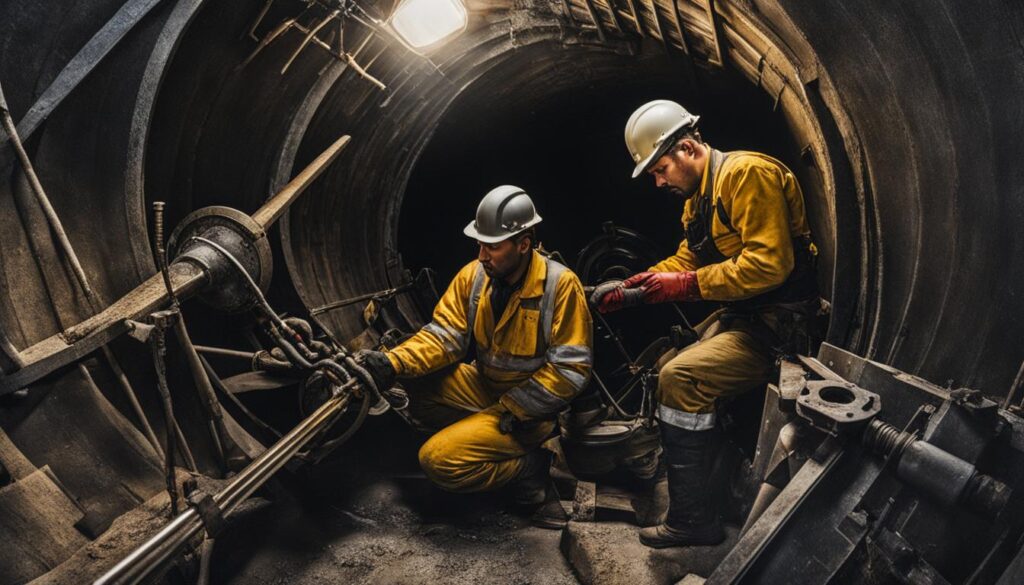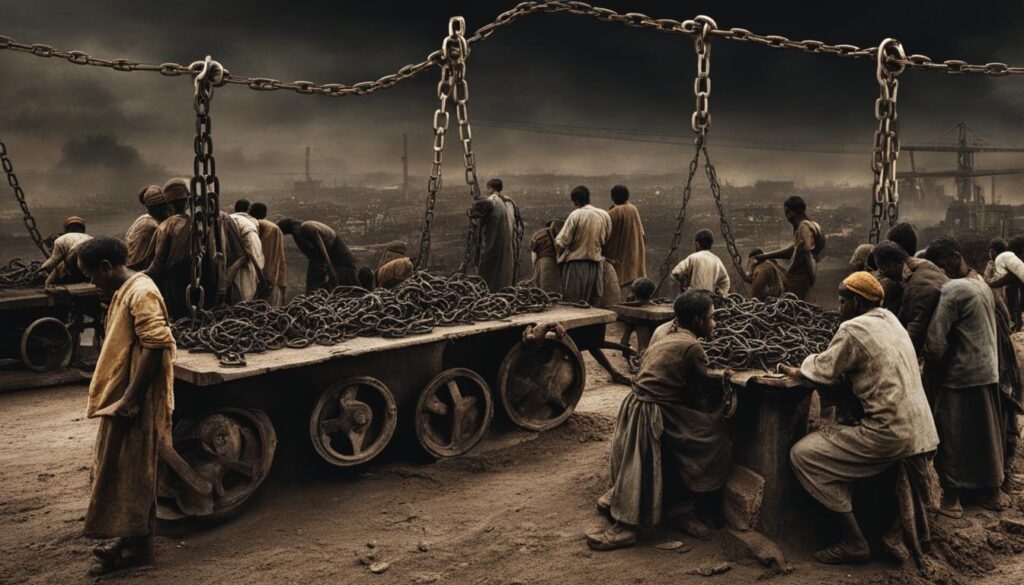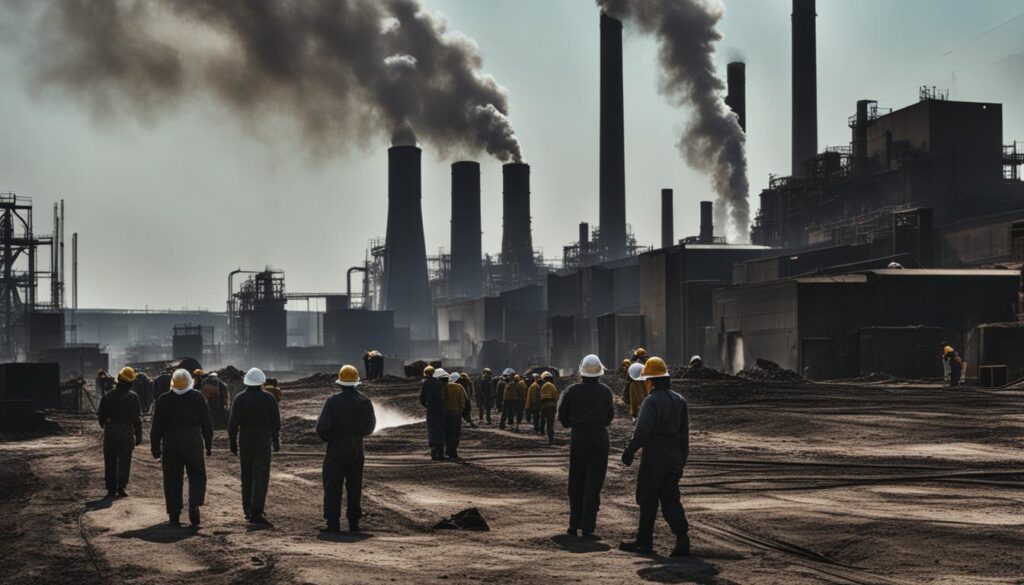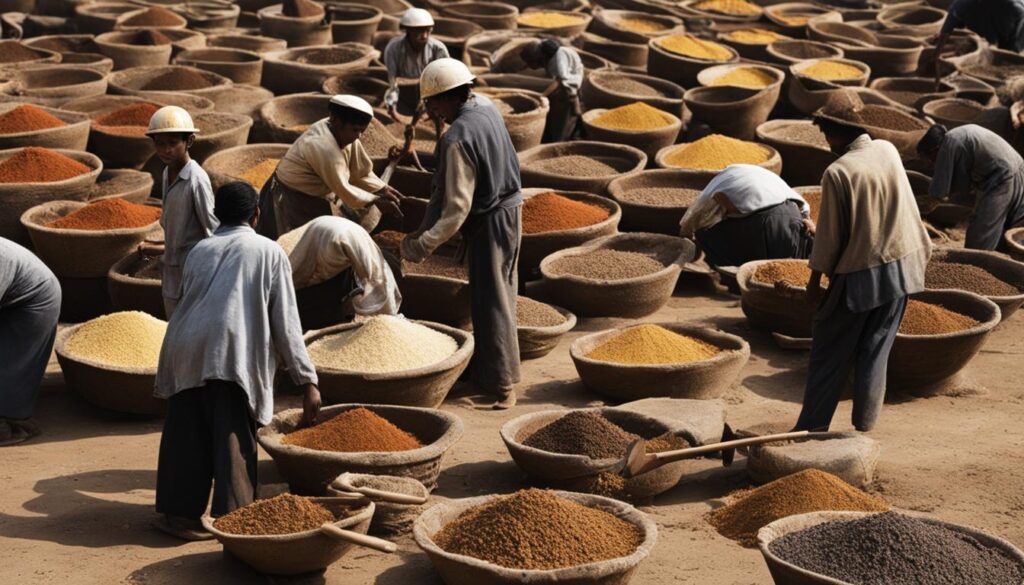Forced labor or coercion is a grave human rights violation that continues to affect millions of people worldwide. Combining elements of human trafficking, modern-day slavery, and labor exploitation, it represents a significant challenge in the fight against human rights violations.
In this section, I will delve into the dynamics of forced labor or coercion, providing an in-depth understanding of its definition, historical context, and legal frameworks. By exploring the intricacies of this issue, we can shed light on the challenges faced by victims and the ongoing efforts to eradicate this heinous practice.

Key Takeaways:
- Forced labor or coercion is a widespread human rights violation.
- It combines elements of human trafficking, modern-day slavery, and labor exploitation.
- Understanding the dynamics of forced labor is crucial in addressing this issue effectively.
- The historical context and legal frameworks provide insights into the severity of the problem.
- Efforts to combat forced labor require a global commitment to human rights and justice.
Defining Forced Labor or Coercion
Forced labor or coercion refers to the systematic practice of exploiting individuals through various forms of coercion, threats, or physical violence, with the aim of forcing them to work against their will. This egregious violation of human rights has plagued societies throughout history and continues to be a pressing issue in the modern world. To understand the gravity of forced labor and coercion, it is crucial to explore its historical context and evolution, as well as the key components that constitute this practice. Moreover, examining the legal definitions and frameworks surrounding forced labor is essential for combating it effectively.
Historical Context and Evolution
Forced labor has deep historical roots, spanning across different time periods and regions. From ancient civilizations and colonial empires to the era of transatlantic slave trade, the brutal practice of coercing individuals into labor has persisted throughout human history. The methods of coercion have evolved over time, reflecting the changing socio-political landscapes and economic structures. Understanding the historical context helps us contextualize today’s manifestations of forced labor and grasp the urgent need for its eradication.
Key Components of Forced Labor
Forced labor encompasses several key components that contribute to its exploitative nature. These components include:
- Coercion and threats of violence: Perpetrators employ intimidation, physical abuse, and threats to control and manipulate individuals, forcing them into labor.
- Restriction of movement and isolation: Victims of forced labor are often subjected to restrictions on their freedom of movement, making it difficult for them to escape their oppressors.
- Debt bondage: Many individuals find themselves trapped in forced labor due to debts they can never repay. Perpetrators exploit this vulnerability to perpetuate labor exploitation.
- Withheld or unpaid wages: Forced laborers are commonly denied their rightful wages or forced to work without any compensation, further exacerbating their vulnerability and dependency.
Legal Definitions and Frameworks
Recognizing the urgency of combating forced labor, legal definitions and frameworks have been established to address this issue at both national and international levels. These legal frameworks provide a foundation for identifying, prosecuting, and protecting victims of forced labor. The International Labor Organization (ILO) defines forced labor under Convention No. 29 as “all work or service which is exacted from any person under the menace of any penalty and for which the said person has not offered himself voluntarily.” Moreover, various countries have enacted legislation to criminalize forced labor and ensure the protection of human rights.
The Global Impact of Coerced Labor
Coerced labor, also known as forced labor or coercion, has far-reaching consequences that affect individuals, communities, and economies worldwide. It perpetuates labor exploitation, resulting in widespread human rights violations and contributing to the persistence of modern-day slavery.
Forced labor victims endure immense suffering, experiencing both physical and psychological abuse while enduring violations of their basic rights. They are subjected to harsh working conditions, long hours, and denial of fair wages. The cruelty and coercion inflicted upon them leave lasting scars and deeply impact their well-being.
Furthermore, coerced labor has economic implications that extend beyond the individuals directly affected. It distorts fair competition in industries, compromising the rights of workers and causing damage to ethical business practices. Additionally, coerced labor leads to a decrease in productivity and quality of goods and services, ultimately undermining economic progress.

Forced labor and labor exploitation, in the form of coercion, not only violate the fundamental rights of individuals but also obstruct sustainable and inclusive economic growth.
To effectively combat coerced labor and its global impact, individuals, communities, corporations, and governments must make concerted efforts. Collaborative action, ethical labor practices, and respect for human rights are crucial in eradicating this heinous practice and ensuring a just and equitable society.
The Intersection of Human Trafficking and Forced Labor
Understanding the Overlap
Human trafficking and forced labor are deeply intertwined, with victims often experiencing both forms of exploitation. The overlap between these two crimes highlights the complexity and severity of the issue. Human trafficking involves the recruitment, transportation, and harboring of individuals by means of force, fraud, or coercion, for the purpose of exploitation, which can include forced labor. Understanding the overlap is essential for effectively combating these abuses.
Victim Identification and Rescue
Victim identification and rescue are crucial steps in addressing human trafficking and forced labor. However, these processes can be challenging due to the clandestine nature of these crimes and the control exercised by traffickers and exploiters. Identifying victims requires a comprehensive approach that involves cooperation between law enforcement, social services, and community organizations. Efforts must focus not only on recognizing physical indicators but also on understanding the psychological and emotional coercion used against victims.
Pathways of Exploitation
Pathways of exploitation refer to the various routes and mechanisms through which individuals are forced into labor and subjected to trafficking. These pathways can be influenced by factors such as poverty, lack of education, gender inequality, and systemic vulnerabilities. Common pathways include recruitment through fraudulent job offers, migration processes, debt bondage, and the manipulation of power differentials. Understanding these pathways is crucial in designing effective prevention strategies and targeted interventions.
| Key Takeaways | Challenges and Considerations |
|---|---|
|
|
Identifying Signs of Labor Exploitation
Identifying signs of labor exploitation is crucial for effectively combating forced labor and coercion. By recognizing the indicators of exploitation, we can take proactive measures to protect vulnerable individuals and promote fair working conditions. Here are some key signs to watch out for:
- Poor working conditions: This can include long hours, unsafe workplaces, lack of protective gear, and inadequate rest breaks. Workers may be subjected to harsh physical conditions, putting their health and well-being at risk.
- Restricted movement: Labor exploitation often involves restricting the freedom of movement of workers. They may be confined to the workplace or living quarters, unable to freely leave the premises or communicate with others outside their immediate environment.
- Unpaid wages: Workers experiencing exploitation may not receive the wages they are entitled to. They may be denied fair compensation for their labor, working without proper contracts or documentation.
- Debt bondage: A form of modern slavery, debt bondage occurs when workers are forced to work to repay a debt that cannot be realistically paid off. They can become trapped in a cycle of indebtedness, with no way to break free from exploitative working conditions.
These signs of exploitation serve as red flags, indicating potential instances of forced labor or coercion. Identifying and reporting such signs is crucial for safeguarding the rights and dignity of workers and eradicating labor exploitation.

Forced Labor in Various Industries
Forced labor is prevalent across various industries globally, perpetuating the cycle of exploitation and violating the rights of workers. In this section, we will delve into three key sectors where forced labor and coercion are commonly found: agriculture and fishing, manufacturing and construction, and domestic work and caregiving. Understanding industry-specific challenges and forms of exploitation, we can actively create effective solutions to combat this pressing issue.
Agriculture and Fishing
In the agriculture and fishing industries, forced labor is a significant concern, with workers being subjected to exploitative working conditions and coercive practices. People, from plantations to small farms, endure debt bondage, long hours, unsafe conditions, and low wages. The absence of legal safeguards and monitoring perpetuates forced labor, necessitating immediate action to combat exploitation in agriculture and fishing.
Manufacturing and Construction
Forced labor is also prevalent in the manufacturing and construction sectors, driven by the demand for cheap labor and the complex global supply chains. Workers in these industries often face hazardous working conditions, excessive working hours, and limited access to labor rights. Migrant workers, tied to specific employers by restrictive visas, face heightened vulnerability to exploitation, unable to escape abuse. Resolving these issues requires increased transparency, responsible sourcing practices, and enforcement of labor laws to protect the rights and well-being of workers.
Domestic Work and Caregiving
The domestic work and caregiving sectors are characterized by a high prevalence of forced labor and exploitation. Many domestic workers, primarily migrant women, are susceptible to various forms of abuse, including physical and verbal violence, withholding of wages, and confinement. The private nature of these settings often hinders detection and intervention. It is crucial to promote fair employment practices, improve legal protections, and raise awareness about the rights of domestic workers to tackle the forced labor entrenched in this sector.
Understanding the specific challenges and dynamics of forced labor in agriculture and fishing, manufacturing and construction, and domestic work and caregiving is essential for developing targeted interventions and ensuring the protection of workers. Through collaborative efforts, industry stakeholders, policymakers, and advocates can work towards eradicating forced labor and creating fair and ethical working environments for all.
Forced Labor or Coercion
Coercion deeply intertwines with forced labor, serving as a means to maintain and enforce labor exploitation. Coercive measures are used to control and exploit individuals, perpetuating a cycle of human rights violation. Understanding the relationship between forced labor and coercion is essential in combating labor exploitation.
By exerting coercive control over individuals, perpetrators ensure compliance and maximize their power over laborers. This can manifest in various forms, such as physical violence, threats, withholding wages, or debt bondage. The aim is to keep workers trapped in exploitative situations, depriving them of their rights and muting their voices.
The use of coercion in labor exploitation not only infringes upon basic human rights but also perpetuates a system of inequality and suffering. Oppressors keep laborers trapped in a vicious cycle, preventing their escape.
To effectively address forced labor and coercion, it is imperative to dismantle the mechanisms that enable and perpetuate these practices. This requires comprehensive legal frameworks, robust enforcement mechanisms, and international collaboration to protect the rights of individuals and hold perpetrators accountable.
By raising awareness about the intricate relationship between forced labor and coercion, we can foster a greater understanding of the complexities surrounding labor exploitation. Through collective action, we can work towards eradicating forced labor, ensuring a more equitable and just society for all.
Forced Labor Laws and International Agreements
The fight against forced labor and coercion is supported by national laws and international agreements. These legal frameworks play a crucial role in eradicating forced labor and protecting the rights of victims. The United Nations, International Labour Organization, and national legislation form the foundation of this global endeavor.
United Nations Protocols
United Nations (UN) protocols address forced labor and coercion on an international scale. The Protocol to Prevent, Suppress and Punish Trafficking in Persons, Especially Women and Children, commonly known as the Palermo Protocol, is a key instrument in combatting human trafficking, which often involves forced labor. The Palermo Protocol provides a comprehensive framework for member states to prevent and prosecute human trafficking, protect victims, and promote international cooperation.
International Labour Organization Conventions
The International Labour Organization (ILO) has developed several conventions specifically targeting forced labor and coercion. The Forced Labour Convention, 1930 (No. 29) and the Abolition of Forced Labour Convention, 1957 (No. 105) aim to eliminate all forms of forced labor, including through coercion and violence. These conventions require member states to adopt effective measures to prevent and suppress forced labor, protect victims, and provide rehabilitation and compensation.
Additionally, the ILO’s Declaration on Fundamental Principles and Rights at Work reinforces the commitment to eradicate forced labor by recognizing it as a fundamental violation of human rights. This declaration emphasizes the importance of social dialogue and cooperation between governments, employers, and workers in promoting decent work and eliminating forced labor.
National Legislation Against Forced Labor
Many countries have enacted national legislation to prevent and combat forced labor within their jurisdictions. These laws may include provisions that criminalize forced labor, establish penalties for offenders, and provide avenues for victims to seek justice and receive support.
For example, the United States has the Trafficking Victims Protection Act (TVPA), which criminalizes human trafficking and forced labor. The UK’s Modern Slavery Act and Australia’s Crimes Legislation Amendment (Slavery, Slavery-like Conditions and People Trafficking) Act also address forced labor and coercion.
It is through these national legislative measures that countries can align with international commitments and take concrete steps to address forced labor and coercion within their borders.
The Role of Corporations in Combating Labor Exploitation
Corporations have a vital role to play in addressing labor exploitation and promoting ethical practices within their supply chains. With their global reach and influence, corporations can make a significant impact in the fight against forced labor or coercion.
One crucial aspect of corporate involvement is embracing social responsibility. By prioritizing human rights and actively working to eliminate forced labor, corporations can create meaningful change. This involves conducting thorough audits of their supply chains to identify any instances of labor exploitation. By identifying potential risks and taking proactive measures to address them, corporations can demonstrate their commitment to eradicating forced labor.
Furthermore, certifications and industry standards can also serve as valuable tools in combating labor exploitation. Adhering to rigorous certifications, such as the Responsible Business Alliance’s Validated Assessment Program or Fair Trade Certification, can provide assurance that a corporation’s supply chain upholds ethical labor practices. These certifications help build trust between corporations, consumers, and stakeholders, paving the way for greater transparency and accountability in the fight against forced labor.
Best practices for ethical labor management also play a crucial role in combating labor exploitation. Corporations must ensure that they educate their employees about the signs of forced labor and provide them with the knowledge to report potential instances. Implementing robust grievance mechanisms and whistleblower protection policies can encourage employees to come forward without fear of retaliation, enabling swift intervention to address labor exploitation.
By embracing corporate social responsibility, conducting thorough audits, adhering to certifications and industry standards, and implementing best practices for ethical labor management, corporations can contribute to the global efforts to combat labor exploitation. By corporations, governments, and civil society collaborating, we can actively create a world where we eradicate forced labor and coercion, and respect the rights of all workers.

Human Trafficking Prevention Initiatives
Preventing human trafficking and forced labor requires a multidimensional approach. In this section, we’ll explore prevention initiatives combatting these crimes, safeguarding at-risk individuals’ rights and dignity
Educational Programs and Awareness Raising
Educational programs are crucial in raising awareness about human trafficking and forced labor. By educating communities, organizations, and individuals, we empower them with knowledge and tools to effectively prevent exploitation. Schools, universities, workplaces, and community centers can implement these programs to ensure broad understanding and active participation.
Targeted campaigns effectively raise awareness by utilizing media channels like television, radio, social media, and online platforms. These campaigns actively spread awareness about human trafficking and forced labor, educating widely on signs and prevention. By amplifying the voices of survivors and sharing their stories, we can inspire empathy and mobilize collective action.
Community-Based Interventions
Community-based interventions play a crucial role in preventing human trafficking and forced labor. Organizations actively engage local communities to address vulnerability roots and implement protective interventions for at-risk individuals. Vocational training, job placement, and income opportunities are key to reducing exploitation and economic vulnerabilities.
Furthermore, community-based interventions facilitate the development of support networks, enabling early identification of potential victims and the provision of necessary assistance. Fostering solidarity and collective responsibility, communities actively engage in preventing and eradicating human trafficking and forced labor.
Public Policy and Advocacy
Public policy and advocacy efforts are essential in driving systemic change and creating an enabling environment for preventing human trafficking and forced labor. Governments and policymakers must develop and enforce robust legislation that criminalizes these offenses and acts as a deterrent against perpetrators.
Advocacy organizations, NGOs, and civil society entities play a vital role in shaping public opinion and influencing policy-making processes. They advocate for stronger legal frameworks and engage in lobbying activities to ensure proper implementation and enforcement of laws. Through advocacy, they also raise public awareness, generate public support, and mobilize resources for prevention initiatives.
Additionally, international collaboration among governments, NGOs, and other stakeholders is crucial in addressing the transnational nature of human trafficking and forced labor. Cooperation in sharing best practices, exchanging information, and coordinating efforts enhances the effectiveness of prevention strategies and strengthens global responses.
Measuring the Scale: Forced Labor Statistics
Understanding the scale of forced labor is crucial for effective intervention and policy development. By examining forced labor statistics and global trends, we can gain insight into the extent of this human rights violation and identify areas that require urgent attention.
Forced labor statistics provide valuable quantitative data that sheds light on the magnitude of the problem. These statistics are sourced from various organizations, including the International Labour Organization (ILO), national governments, and non-governmental organizations (NGOs) working in the field.
The hidden nature of forced labor poses a key challenge in measurement. Worldwide, concealed criminal activities make it difficult to accurately capture its full scope.However, efforts are being made to improve data collection and reporting mechanisms to provide more comprehensive statistics.
Global trends in forced labor highlight patterns and shifts in the prevalence and nature of coercion and labor exploitation. These trends empower policymakers, activists, and organizations to identify emerging issues, customize interventions, and allocate resources more effectively.

The image above provides a visual representation of forced labor statistics, reflecting the global trends that have been observed. These alarming statistics demand immediate action; we must intensify our fight against forced labor and staunchly defend victims’ rights.
Forced Labor Statistics: An Overview
To gain a comprehensive understanding of forced labor, let’s explore some key statistics:
| Region | Estimated Number of Victims |
|---|---|
| Asia-Pacific | 25 million |
| Africa | 9 million |
| Europe and Central Asia | 3.9 million |
| Americas | 1.9 million |
| Middle East and North Africa | 800,000 |
These statistics provide a glimpse into the global scope of forced labor and its disproportionate impact on different regions. Importantly, estimated figures represent only the tip of the iceberg, as underreporting and limited data access likely result in higher actual numbers.
Analyzing forced labor stats, we actively boost awareness, advocacy, and policy change, aiming to eradicate this human rights violation.
Supporting Survivors of Forced Labor
Supporting survivors of forced labor is crucial to their healing and successful reintegration into society. We can empower survivors to rebuild their lives by actively providing essential support and resources, helping them overcome trauma. In this section, we will explore the different forms of support available to survivors, including rehabilitation and recovery programs, legal assistance and advocacy, and empowerment through education and employment opportunities.
Rehabilitation and Recovery Programs
Rehabilitation and recovery programs are essential for survivors of forced labor to regain their physical and psychological well-being. These programs focus on providing comprehensive care, including medical treatment, counseling, and trauma therapy. They aim to address the immediate needs of survivors and help them navigate the path to recovery. By offering a safe and supportive environment, these programs play a crucial role in rebuilding the lives of survivors.
Legal Assistance and Advocacy
Legal assistance and advocacy are fundamental in supporting survivors of forced labor in seeking justice and holding perpetrators accountable. Survivors often face numerous legal challenges, including navigating complex legal systems and accessing their rights. Legal aid organizations provide crucial support by offering free legal advice, representation, and assistance in filing lawsuits against perpetrators. Additionally, advocacy efforts proactively raise awareness about forced labor, driving policy changes to protect survivors and prevent future exploitation.
Empowerment Through Education and Employment
Empowerment through education and employment is essential for survivors of forced labor to regain their independence and build a sustainable future. Education programs empower survivors, bolstering their skills and knowledge, consequently enabling them to pursue further education or secure employment. Vocational training and job placement programs empower survivors by providing essential tools for financial support and achieving economic independence. Empowering survivors with education and employment, we actively break the cycle of exploitation, forging a path to a brighter future.
Conclusion
Forced labor and coercion present significant challenges in our ongoing fight against labor exploitation and human rights violations. These practices not only violate the basic rights and dignity of individuals but also hinder economic progress and social development. However, global efforts aimed at eradicating forced labor and coercion continue to make progress.
Recognizing and addressing forced labor and coercion demands a comprehensive approach, actively involving governments, corporations, civil society, and individuals. Working together actively, we can build a world free from exploitation, ensuring everyone exercises their fundamental rights.
Actively raising awareness, advocating robust legal frameworks, and championing ethical labor practices are crucial to combating forced labor and coercion. We must prioritize protecting vulnerable individuals and ensure holding perpetrators accountable for their actions.
Moving forward, we must actively remember: eradicating forced labor and coercion requires continuous, steadfast commitment, not just one-time action. Actively fighting labor exploitation, we contribute decisively to building a more just, equitable society for everyone.
FAQ
What is forced labor or coercion?
Forced labor or coercion is the practice of exploiting individuals through various forms of coercion, threats, or physical violence to force them to work against their will.
What is the historical context and evolution of forced labor?
Understanding the historical context and evolution of forced labor helps us grasp the severity of this issue and how it has evolved over time.
What are the key components of forced labor?
Forced labor consists of several key components, including physical or psychological coercion, restrictions on movement, and the absence of consent.
What are the legal definitions and frameworks surrounding forced labor?
Legal definitions and frameworks exist to combat forced labor, including international conventions and national legislation.
What is the global impact of coerced labor?
Coerced labor has severe consequences for individuals, communities, and economies worldwide, contributing to modern-day slavery and perpetuating human rights violations.
How does human trafficking intersect with forced labor?
Human trafficking and forced labor are often interconnected, with victims experiencing both forms of exploitation.
How can we identify signs of labor exploitation?
Identifying signs of labor exploitation is essential in combating forced labor, including indicators such as poor working conditions, restricted movement, and debt bondage.
In which industries does forced labor exist?
Forced labor exists in various industries, including agriculture and fishing, manufacturing and construction, and domestic work and caregiving.
How is forced labor related to coercion?
Forced labor and coercion are intertwined, as coercion is used to maintain and enforce labor exploitation.
What are the laws and international agreements against forced labor?
The fight against forced labor is supported by international agreements, such as United Nations protocols and International Labour Organization conventions, as well as national legislation.
What is the role of corporations in combating labor exploitation?
Corporations have an important role in addressing forced labor within supply chains through corporate social responsibility, audits, and certifications.
What initiatives exist to prevent human trafficking?
Various initiatives aim to prevent human trafficking and forced labor, including educational programs, community-based interventions, and public policy and advocacy.
How can we measure the scale of forced labor?
Measuring the scale of forced labor is crucial for intervention and policy development, and there are various statistics and global trends that provide insights into its extent.
How can we support survivors of forced labor?
Supporting survivors of forced labor includes providing rehabilitation and recovery programs, legal assistance and advocacy, and empowerment through education and employment opportunities.

